Best tools for benchmarking competitor content marketing?


A review of 3 social sharing count tools showing which competitor content types are most popular
Part of the process of defining a content marketing strategy for your business is to evaluate the performance of your competitors’ content marketing and SEO efforts. The insight you can glean from what both direct and indirect competitors are doing will allow you to build a picture of the type of content activity, strategies and tactics that are working for others in your industry and what, as a result, might best work for you. In short, a competitor analysis can tell you:
- The content types and ideas getting most traction measured by number of shares or backlinks
- Content gaps in your plans compared to competitors, evaluated using the Smart Insights content marketing matrix for examples
- Competitors’ strengths and weaknesses, and the opportunities and threats from the wider market – a content competitor analysis can be used as part of a wider competitive analysis and the various online competitor benchmarking tools available.
Traditionally SEOs have reviewed content or ‘linkbait’ effectiveness using backlink checking tools like Majestic SEO or Moz, but there is now a newer approach based on measuring the number of social shares across the main social networks. In this post I review three relatively new tools which help answer the first question of which content types are most effective for competitors.
Download free resource – Essential Digital Marketing Tools
This guide will recommend the best types of tools and the most popular alternatives in each category based on our experience and talking to other marketers..
Access the Essential Digital Marketing Tools 2016
Please share which tool you find best, for us it’s between these two, but do share other ideas in the comments. Thanks.
3 free analysis tools for reviewing competitors’ content marketing performance
There are a number of helpful tools available, each with differing price ranges, pros and cons, to help you to analyse content from across the web. In this post we’re going to look at three free stand-out tools that you can start using today to begin assessing the content performance of your and competitors’ websites:
1. Socialcrawlytics.com
Overview: One of the best established social share counting tools reviewed by Dave Chaffey in 2012, Socialcrawlytics allows you to analyse the social sharing performance of any given URL. By evaluating how content has been shared across multiple social networks, you can begin to determine what content is getting the most traction on which social network and how it is performing versus objectives.
This process enables you to see how competitor content is performing and how it’s being constructed in terms of keywords, themes, style and structure.
Although users have to sign up for Socialcrawlytics.com via their Twitter account, once in simply enter a URL you wish to analyse and Socialcrawlytics crawls the site and prepares a detailed report outlining how and where content has been shared:
Key features of Socialcrawlyltics
- For any given URL, Socialcrawlytics provides an overview of shares across a range of social networks.
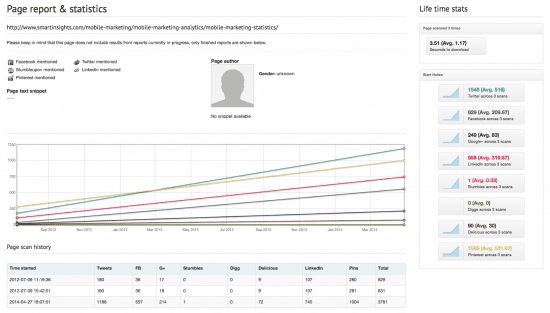
- Provides a % breakdown of social performance by social network so you can easily see where a site is over or under-indexing .
- Offers detailed, graphical detail of what sections, and associated content, is being shared:
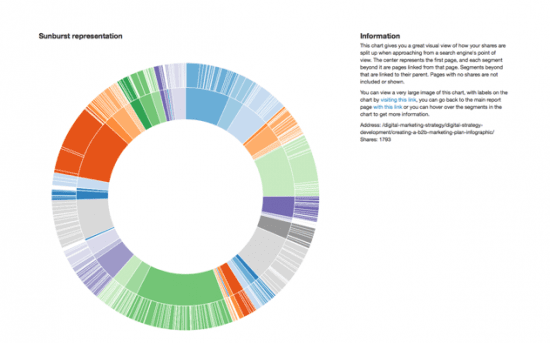
- Easily compare the level of sharing between yours and competitors’ sites.
- Export results and categorise by content to get practical ideas of type of posts you should be creating to engage your audience:

Drawbacks of Socialcrawlytics
It would be good to see some information around backlinks to a URL so that comparisons can be made between social shares and links, as well as some additional detail on who is sharing what content the most.
Also, because the tool conducts an in-depth crawl of a site, it can sometimes take some time before full results are returned. If you’re looking for a quicker snapshot of results, the other tools reviewed here are probably a better bet.
However, as the saying goes: good things come to those who wait. And that’s definitely the case with Socialcrawlytics. The insight and level of detail this tool provides is excellent considering it’s free and can provide users with a wealth of knowledge about how a site is performing from a social media perspective.
For some additional analysis of Socialcrawlytics, check out Dave’s post from last year.
2. Quick Sprout
Overview: As with many of the best tools available, Neil Patel’s Quick Sprout is an all-round website analysis solution but has a number of very useful features that provide useful insights into how content is performing.
Key features of Quick Sprout
- Great tool for those new to SEO as well as more experienced users.
- Clear, simple and succinct visuals.
- Data can be downloaded as PDF and/or Excel files.
- Provides a series of overview data that can be drilled down to find more detail, e.g.
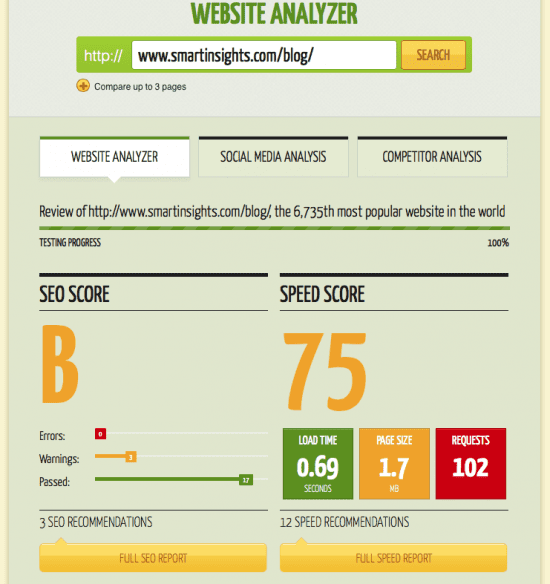
Content analysis covers:
- Speed test
- Top keywords and phrases
- Backlink counter
- Social media analysis offers a comprehensive evaluation of which pages have generated shares on key social networks, including Google+, Facebook, Twitter, Pinterest and LinkedIn:
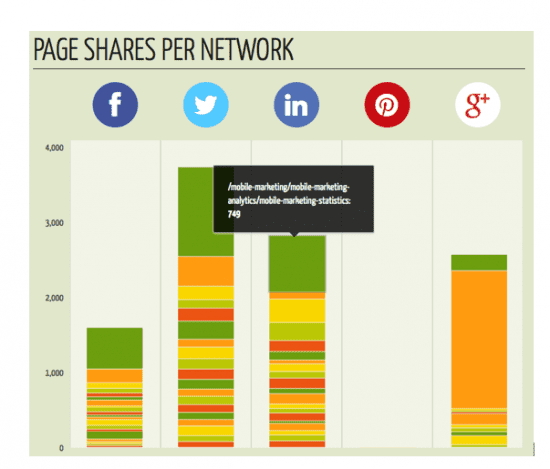
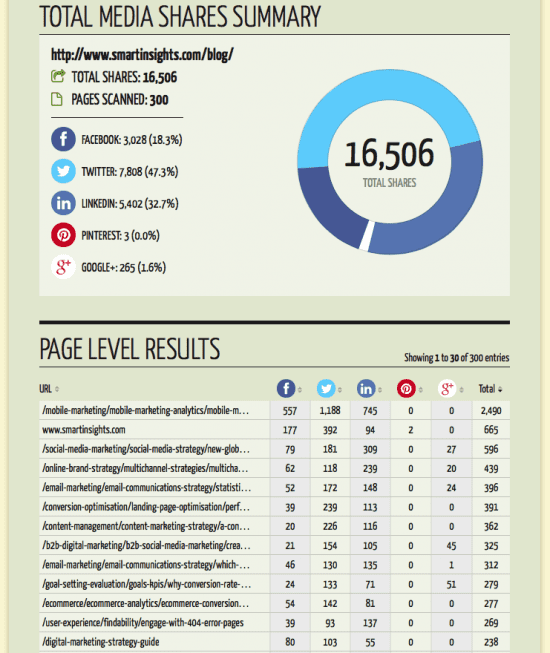
- The competitor analysis feature allows users to evaluate their website against up to three competitor sites:
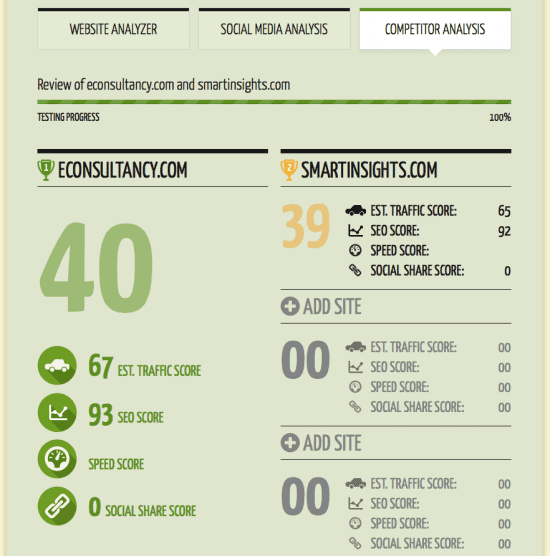
Drawbacks of Quick Sprout
Because the tool provides a holistic view of a site, it’s not designed to specifically evaluate content and content marketing effectiveness alone unlike Socialcrawlytics and BuzzSumo, so some users could get over-awed by the amount of data Quick Sprout provides.
Nevertheless, besides some frustrating limitations with the competitor comparison analysis (which I found to work only intermittently), the fact that Quick Sprout does provide an overall website analysis will certainly be an advantage for those looking to make wider SEO and content changes to their websites.
To really understand how content is performing (beyond simply how much it’s being shared), users need to get a clear view as to how it is being rendered on different devices, how quickly pages are loading and where keywords are being neglected, all valuable data that Quick Sprout delivers.
3. BuzzSumo
Overview: Whilst BuzzSumo provides much of the functionality offered by Socialcrawlytics and Quick Sprout, the tool’s simplicity, ease of use and speedy performance means it still offers some really useful insights for those looking for a quick snapshot of how a website or web page’s content is performing across multiple social channels.
Key features of BuzzSumo
- The opening page offers a really quick, handy guided tour of how the tool works.
- Provides a clear, simple snapshot of social performance of different pages within a domain:
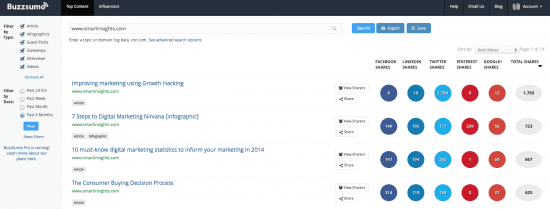
- Users can also search by topic.
- Data is easily filtered by content type and date.
- Provides detail about the Twitter users who have shared the content, all of whom can be sorted by page authority or followers, and filtered further by ‘bloggers’, ‘influencers’, ‘companies’, ‘journalists’ and ‘regular people’.
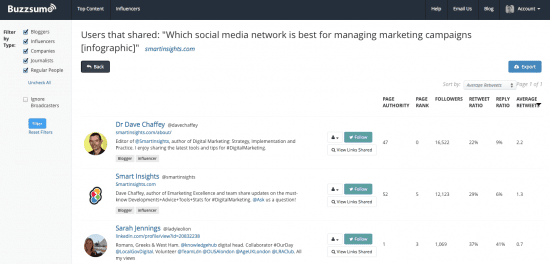
- Search for key influencers by topic or keyword.
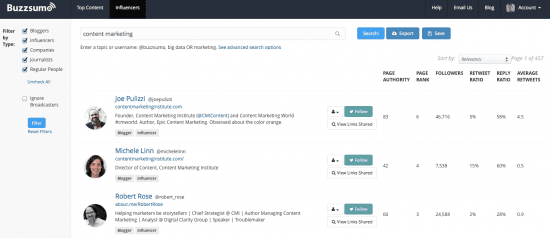
- Searched can be saved and data exported to CSV or Excel files.
Drawbacks
In comparison to Socialcrawlytics and Quick Sprout, BuzzSumo is limited in that it only offers users data for five social networks and doesn’t provide anywhere near the depth of insight that the other two tools offer. It would also be good to see BuzzSumo offer extra detail on who shared data from other social networks (although obviously this may be limited based on the each user and social network’s privacy settings).
However, the current benefits and features of BuzzSumo far outweigh the negatives and besides there’s a ‘pro’ version in the pipeline that may well solve some of the drawbacks referenced above.
Summary of the benchmarking tools
It’s difficult to pick a ‘winner’ from each of the tools reviewed above. Whilst all being free, each also have their own distinct features and benefits and are useful for different reasons based on the level of insight you’re looking to get.
I would advise readers looking to analyse content, whether it be their own or their competitors’, to use a combination of all three tools. Whereas Quick Sprout can provide granular detail regarding on-page content factors such as keywords, page speed and meta data, BuzzSumo provides a great overview of where content is being shared (and by whom) and Socialcrawlytics offers an even greater level of detail, with clear percentage breakdowns all exportable so that data can be analysed further.
From our sponsors: Best tools for benchmarking competitor content marketing?



